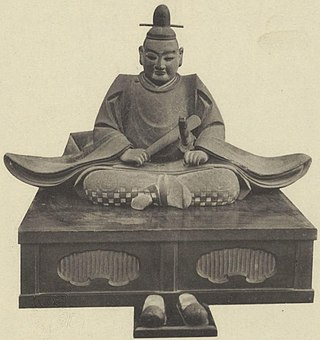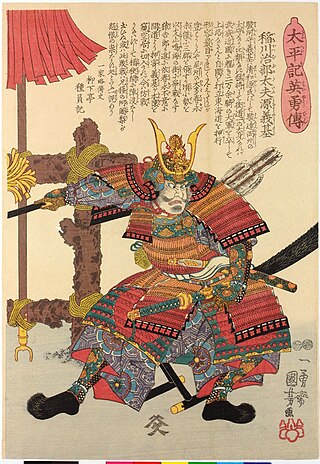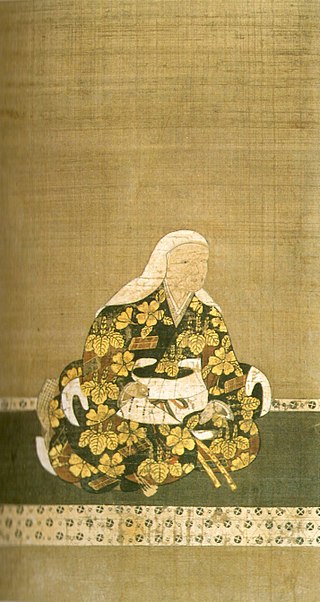Related Research Articles

Tokugawa Ieyasu was the founder and first shōgun of the Tokugawa Shogunate of Japan, which ruled from 1603 until the Meiji Restoration in 1868. He was one of the three "Great Unifiers" of Japan, along with his former lord Oda Nobunaga and fellow Oda subordinate Toyotomi Hideyoshi. The son of a minor daimyo, Ieyasu once lived as a hostage under daimyo Imagawa Yoshimoto on behalf of his father. He later succeeded as daimyo after his father's death, serving as ally, vassal and general of the Oda clan, and building up his strength under Oda Nobunaga.

Oda Nobuhide was a Japanese daimyō and magistrate of the Sengoku period known as "Tiger of Owari" and also the father of Oda Nobunaga the first "Great Unifier" of Japan. Nobuhide was a deputy shugo (Shugodai) of lower Owari Province and head of the Oda clan which controlled most of Owari.

Imagawa Yoshimoto was a Japanese daimyō of the Sengoku period. Based in Suruga Province, he was known as The number one Daimyō in the Tōkaidō; he was one of the three daimyō that dominated the Tōkaidō region. He died in 1560 while marching to Kyoto to become Shogun. He was killed in the village of Dengakuhazama in Okehazama by Oda Nobunaga.
The Siege of Marune (丸根砦の戦い) was a battle during the Sengoku period of Japan. Marune was a frontier fortress in the possession of Oda Nobunaga.

The Battle of Okehazama took place in June 1560 in Owari Province, located in today's Aichi Prefecture. In this battle, the heavily outnumbered Oda clan troops commanded by Oda Nobunaga defeated Imagawa Yoshimoto and established himself as one of the front-running warlords in the Sengoku period.
The siege of Terabe Castle took place in 1558 in feudal Japan. Terabe Castle was a possession of the Ogasawara clan of Mikawa province. The Siege of Terabe Castle was Matsudaira Motoyasu's first battle, who would later change his name to Tokugawa Ieyasu.

Ii Naomasa was a general under the Sengoku period daimyō, and later shōgun, Tokugawa Ieyasu. He is regarded as one of the Four Guardians of the Tokugawa along with Honda Tadakatsu, Sakakibara Yasumasa, and Sakai Tadatsugu. He led the clan after the death of his foster mother, Ii Naotora. He married Tobai-in, Matsudaira Yasuchika's daughter and adopted daughter of Tokugawa Ieyasu.
Matsudaira Hirotada was the lord of Okazaki Castle in Mikawa province, Japan during the Sengoku Period of the 16th century. He is best known for being the father of Tokugawa Ieyasu, founder of the Tokugawa Shogunate.
Imagawa Ujizane was a Japanese daimyō who lived in the Sengoku through early Edo periods. He was the tenth head of the Imagawa clan, and was a son of Imagawa Yoshimoto and the father of Imagawa Norimochi and Shinagawa Takahisa.

Imagawa clan was a Japanese samurai clan that claimed descent from the Seiwa Genji by way of the Kawachi Genji. It was a branch of the Minamoto clan by the Ashikaga clan.

The Matsudaira clan was a Japanese samurai clan that descended from the Minamoto clan. It originated in and took its name from Matsudaira village, in Mikawa Province. During the Sengoku period, the chieftain of the main line of the Matsudaira clan, Matsudaira Motoyasu became a powerful regional daimyo under Oda Nobunaga and Toyotomi Hideyoshi and changed his name to Tokugawa Ieyasu. He subsequently seized power as the first shōgun of the Tokugawa shogunate which ruled Japan during the Edo period until the Meiji Restoration of 1868. Under the Tokugawa shogunate, many cadet branches of the clan retained the Matsudaira surname, and numerous new branches were formed in the decades after Ieyasu. Some of those branches were also of daimyō status.

Sakuma Morishige was a Japanese samurai from Sakuma clan who served Oda Nobunaga. He is believed to be the first "general' killed by gunfire in Japan.
The siege of Kaminogō Castle was a battle in 1562, during the Sengoku period of Japan. Kaminogō Castle was an Imagawa clan outpost located in eastern Aichi Prefecture, in what is now the town of Gamagōri.

Okazaki Domain was a feudal domain of the Tokugawa shogunate in Edo period, Japan located in eastern Mikawa Province, Japan. It was centered on Okazaki Castle in what is now the city of Okazaki, Aichi. It was ruled by a number of different fudai daimyō over the course of the Edo period. Due to its associations with Tokugawa Ieyasu, who was born in Okazaki Castle, the domain had a prestige greater than in its nominal valuation based on rice tax revenues.

Lady Tsukiyama or Tsukiyama-dono was a Japanese noble lady and aristocrat from the Sengoku period. She was the chief consort of Tokugawa Ieyasu, the daimyō who would become the founder and first shōgun of the Tokugawa shogunate. She was the mother of Ieyasu's first child, Kamehime, and gave birth to Ieyasu's heir apparent, Matsudaira Nobuyasu. As principal consort, Tsukiyama led many of the political achievements of the former Matsudaira clan. She was an important figure at the beginning of Ieyasu's career, who later led to the beginning of Tokugawa Shogunate. She is best known for possibly initiating a conspiracy against Oda Nobunaga. Whether or not she cheated Ieyasu into joining the Takeda clan; the veracity of this event remains one of the greatest mysteries of the Sengoku period, known as the Nobuyasu Incident.
Ii Naotora was a daimyō of the Sengoku period. She was the daughter and only child of Ii Naomori, the eighteenth head of their clan. She was primarily the head of Ii clan and retainer of the Imagawa clan, because of her efforts, Ii Naotora became a daimyō and received the title "Female Landlord" (女地頭).
Tokugawa Ieyasu is a 1983 Japanese television series. It is the 21st NHK taiga drama. The drama is based on the novel of the same name by Sōhachi Yamaoka.

Ōtaka Castle was a Sengoku period flatland-style Japanese castle located in what is now part of Midori Ward of the city of Nagoya, Aichi in the Tōkai region of Japan. The ruins, together with that of the detached fortresses of Marune-toride (丸根砦跡) and Washizu-toride (鷲津砦跡) have been collectively protected as a National Historic Site since 1944.

Odai no kata, also known as Dai, Daishi, and Denzûin, was a Japanese noble lady from the Sengoku period.
References
- West, C. E. and F. W. Seal (2004). "Imagawa Yoshimoto". Samurai Archives. Accessed 7 July 2005.